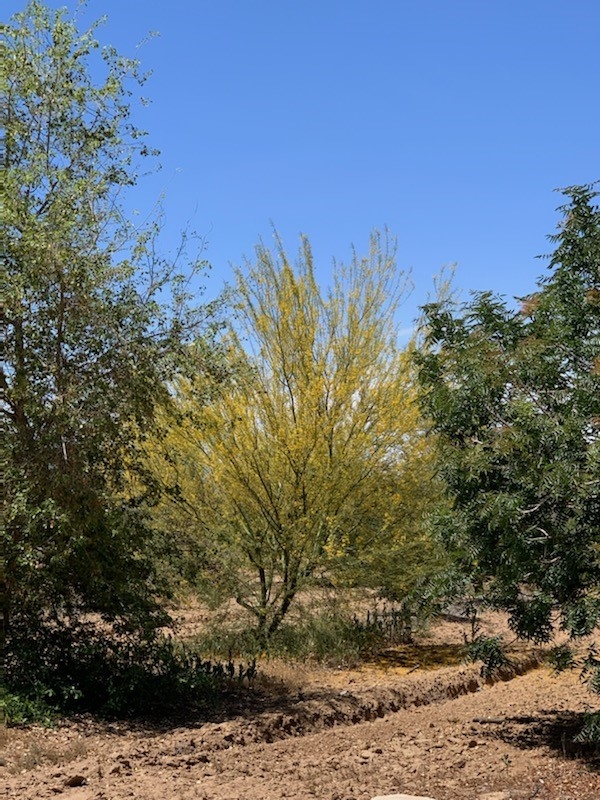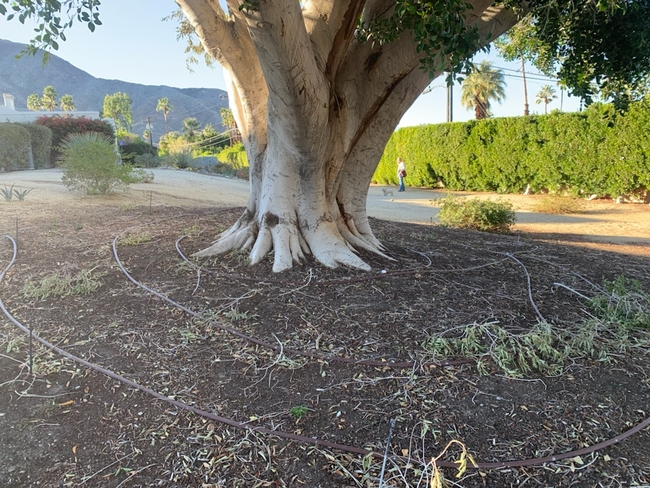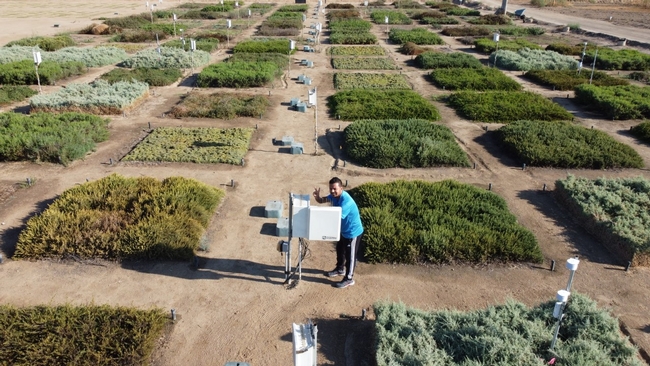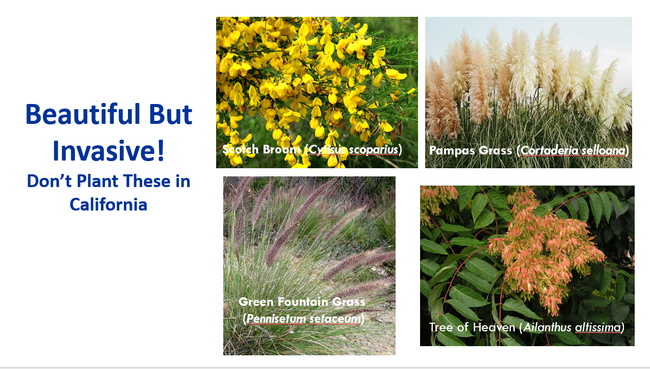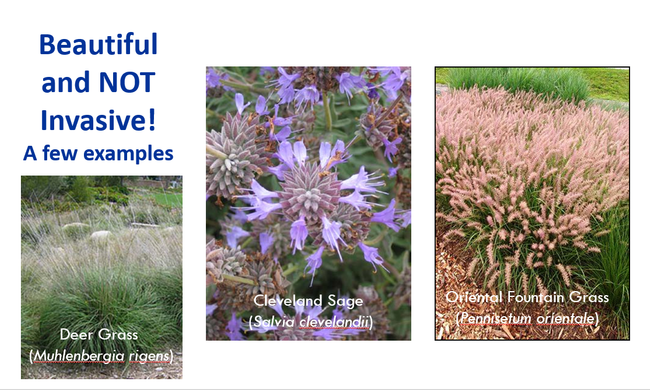
Posts Tagged: ornamental
Save trees first: Tips to keep them alive during drought
Trees essential to lowering temperatures, cooling ‘heat islands'
Water restrictions prompted by the drought are driving Californians to prioritize how they will use their limited water. Because landscape irrigation is a major water use for many households, residents are looking outdoors to conserve water.
When choosing which landscape plants to save, “trees come first,” said Janet Hartin, UC Cooperative Extension area environmental horticulture advisor for San Bernardino, Los Angeles and Riverside counties. “Healthy communities need trees. Fortunately new California water restrictions allow for provisions to ensure trees receive adequate water to stay alive and healthy.”
“Mature trees are instrumental in cooling urban heat islands and we can't afford to lose them and start all over,” Hartin said. “Shade from mature trees can reduce surface temperatures by as much as 65 degrees in asphalt-covered parking lots. Shade from a single tree can reduce these surface temperatures from 165 to less than 100 degrees when air temperatures reach 110 degrees. Even with air temperatures in the 90s, surface temperatures can reach 140 degrees.”
In addition to providing shade, trees absorb and store carbon dioxide, release oxygen, enhance pollinators and wildlife habitat, filter pollutants from air and water and can reduce energy use, according to Hartin. Because trees take years to grow, they aren't as easily replaced as other plants.
As residents let lawns go brown, she recommends watering trees that are near or surrounded by lawn.
“If a tree is in the middle of a lawn, it is almost certainly watered by lawn irrigation,” Hartin said. “If it's not on a separate drip system, drag out a hose and allow the water to slowly trickle into the soil early in the morning or in the evening. Deep watering for two hours once every couple of weeks will keep most established trees alive."
In most jurisdictions, watering restrictions do not apply to hand watering and hand-held watering devices such as hoses, which may be used for longer periods of time than the restrictions permit otherwise. However, watering may be restricted in all cases to prescribed times of day.
“Check to see if your jurisdiction also requires a hose shutoff valve,” Hartin said.
“For fruit trees, we may have to forgo fruit production for a year or so. There may not be enough water to support fruit production, but the goal is to keep the trees alive during the drought,” she said.
She recommends watering trees away from the trunk, halfway between the trunk and the dripline – where the foliage ends and rain drips off the leaves – because “roots grow outward quite a distance as well as downward. Leave the hose on so the water is just trickling out,” she said. “You want water to seep into the soil and encourage the roots to grow deeper. The slow water flow will seep down a foot or so and the roots will follow, which will help anchor the tree. Move the hose around every half hour to hour in quadrants around the tree for more even watering.”
Don't have time to move the hose? Hartin suggests getting a soaker hose and wrapping it in concentric circles 2 to 3 feet apart.
“Soaker hoses are made from recycled tire rubber and allow water to slowly ooze out of the pores along the hose, distributing the water fairly evenly throughout the hose length. Avoid using soaker hoses longer than 75 feet due to pressure issues.”
To reduce evaporation around the tree, spreading mulch a few inches from trunk can help.
“Dark mulches can heat the environment so it's best not to use them,”Hartin said. “If you are in a fire-prone area, don't use organic wood-based mulches because they are flammable. Use decomposed gravel or pebbles, rock-based products instead. To keep sunlight out and discourage weeds, large wood chip mulches should be maintained 3-4-inches deep and smaller inorganic mulches at 1-2 inches.”
Residents may want to maintain some grass for children and pets because bare feet and paws can sustain serious burns on surfaces hotter than 120 degrees.
“People don't realize how hot fake grass can get,” Hartin said. “Research I conducted last summer in the Coachella Valley and Redlands found that surface temperatures of synthetic lawns can be more than 65 degrees higher than living turf and groundcover surfaces on several dates in between May and August.”
For California lawns, there are drought-tolerant grasses that can thrive on 30% less water than bluegrass and other cool season varieties. Examples are buffalograss and bermudagrass. They still require maintenance, such as mowing, but are great for play and recreational surfaces for people and pets.
Jim Baird, UC Cooperative Extension turf specialist based at UC Riverside, said, “Turfgrasses offer numerous recreational, aesthetic, and environmental benefits including player safety, property value, mental health, erosion control, groundwater recharge and surface water quality, organic chemical decomposition, carbon sequestration and environmental cooling.”
There are also non-turf groundcovers that are drought resistant.
“As they transpire, plants cool the environment. We have more and more drought-resistant alternatives to high-water-requiring plants on the market now, and that's where we should be going,” Hartin said.
For people considering replacing their lawns and adding new landscape plants, she recommends planting low-water using groundcovers in the fall.
“It's too hot to plant in summer and even native and drought-resistant plants require water several times week until they get established,” she said.
Most counties have a UC Master Gardener Program with a helpline staffed by well-trained volunteers dispensing advice to help keep plants alive and recommend plants that are well-suited for the local environment. Find a local UC Master Gardener Program at https://mg.ucanr.edu/FindUs.
University of California Cooperative Extension
Drought and Landscape Tree Care Resources
Keeping Plants Alive Under Drought and Water Restrictions (English)
https://anrcatalog.ucanr.edu/pdf/8553.pdf
Mantener las plantas del exterior vivas con poca agua (Spanish)
https://anrcatalog.ucanr.edu/pdf/8628.pdf
Prioritizing Trees Under Drought and Water Restrictions (5-minute video)
https://www.youtube.com/watch?v=CTKLlJgdLVk
Tips to Keep Your Landscape Trees Alive During Drought
Landscape Tree Irrigation to Maximize Tree Health, Benefits, and Beauty
Landscape Tree Irrigation 101
Top 10 Ways to Conserve Water in Your Landscape and Garden
Use of Graywater in Urban Landscapes in California
https://anrcatalog.ucanr.edu/Details.aspx?itemNo=8536
Invasive Plants: Don't Encourage 'Bad Neighbors'
What do ice cream, potato chips, Scotch and Spanish Broom, and Tree of Heaven have in common? While they're all tempting to indulge in, less is more. In fact, plants such as Scotch, Spanish Broom, Tree of Heaven, Pampas Grass, Green Fountain Grass, and dozens of plants are all considered invasive plants in California. Simply put, they should not be planted. There are some great alternative plants that are better choices listed at the end of this blog.
Truth be told, I admit to falling madly in love with the Spanish Broom (Spartium junceum) shrubs adorning Highway 18 on my drive from San Bernardino to Lake Arrowhead in early spring 1984 right after my job interview for my current position. Being a “wet behind the ears” recently hatched graduate student from the Midwest I was truly in awe of their lovely yellow blooms and vowed to plant one if I got the chance to move to California. Fortunately, I found out very soon that, while the plantings were made on purpose, they were a mistake and needed to be removed due to their invasive nature.
While they were ‘recruited' from Europe and had what seemed like a perfect resumé (fast growth, lovely yellow flowers, adaptability to poor infertile soil and disease and insect-resistance), they didn't play well with others, a fatal flaw. In California, they were aggressive and crowded out native plantings. Fires only exacerbated the situation. After the 2003 burns, the Spanish Broom populations exploded, obliterating any remaining natives and taking an even larger area hostage. In summer 2010, the San Bernardino National Forest removed the plants in a costly but necessary $500,000 project under a partnership with the American Recovery and Reinvestment Act. Constant monitoring continues in the San Bernardino Mountains and other areas of the state to prevent its reestablishment which is challenging due to its ability to quickly resprout, seed longevity, and effective dispersal. It has definitely earned its ‘noxious weed' label!
This is just one example of the problems posed by invasive plants. In effect, they grow too well! They outcompete desirable plants in our gardens, lawns, and other urban and natural areas for water, nutrients, and space. They also shade sun-requiring plants. Threatened and endangered plant species and other California native plants are particularly vulnerable to their encroachment. (In most cases, invasive plants are non-native species.) Interestingly, our beloved state flower, the California poppy, is an invasive plant in New Zealand, Hawaii and other locations outside of California.
As urban gardeners, we can all greatly reduce the impact of the encroachment of invasive plants in our urban environments. Please don't plant invasive sane remove plantings on your property to stop their spread. Below are some great resources to learn more about invasive plants and find viable replacements:
California Invasive Plant Council: https://www.cal-ipc.org/
Don't Plant a Pest: https://www.cal-ipc.org/solutions/prevention/landscaping/dpp/
Invasive Plants of Southern California:https://www.cal-ipc.org/solutions/prevention/landscaping/dpp/?region=socal
PlantRight: https://plantright.org/about-invasive-plants/plant
Insect and Mite Pests on Roses
Roses are popular ornamental plants grown in home gardens, parks, and other landscapes. Just like...
Choosing ornamental plants for reduced invasiveness and flammability in the wildland-urban interface
The global horticultural trade in ornamental plants is well known to be a primary source of...
Keep an Eye out for Powdery Mildew
This time of year, you may notice a white, powdery looking growth on fruit, vegetable plants or...

